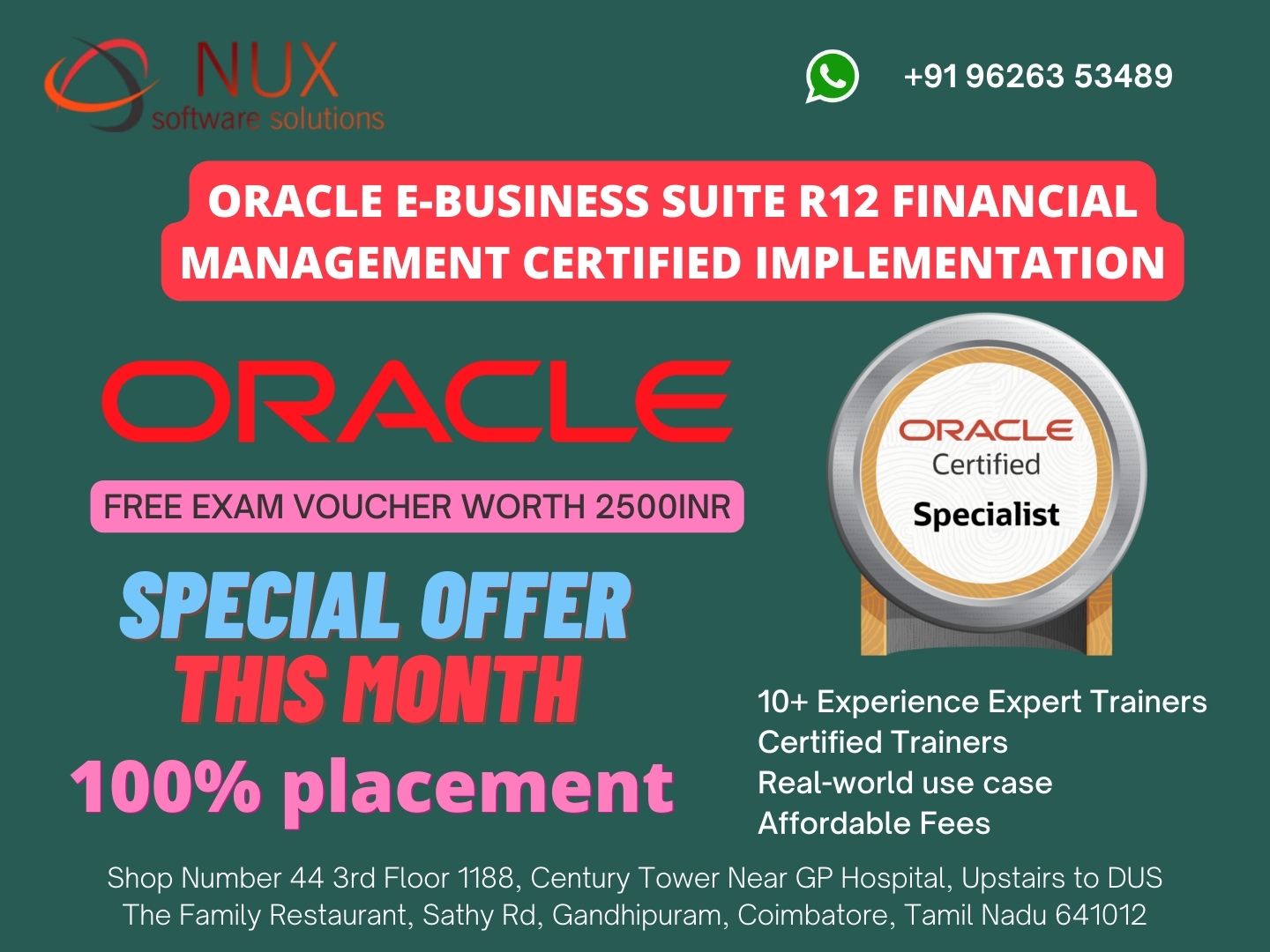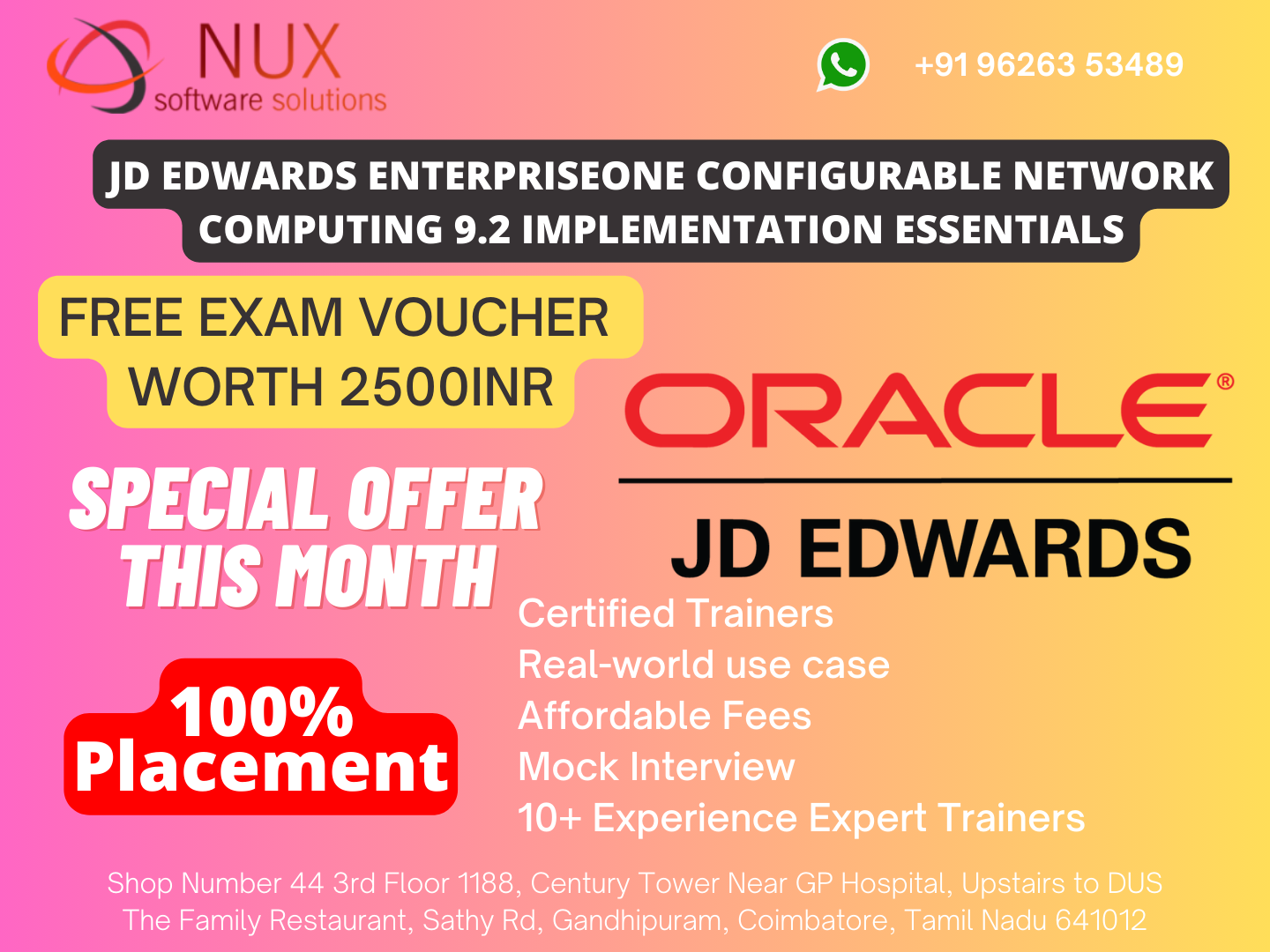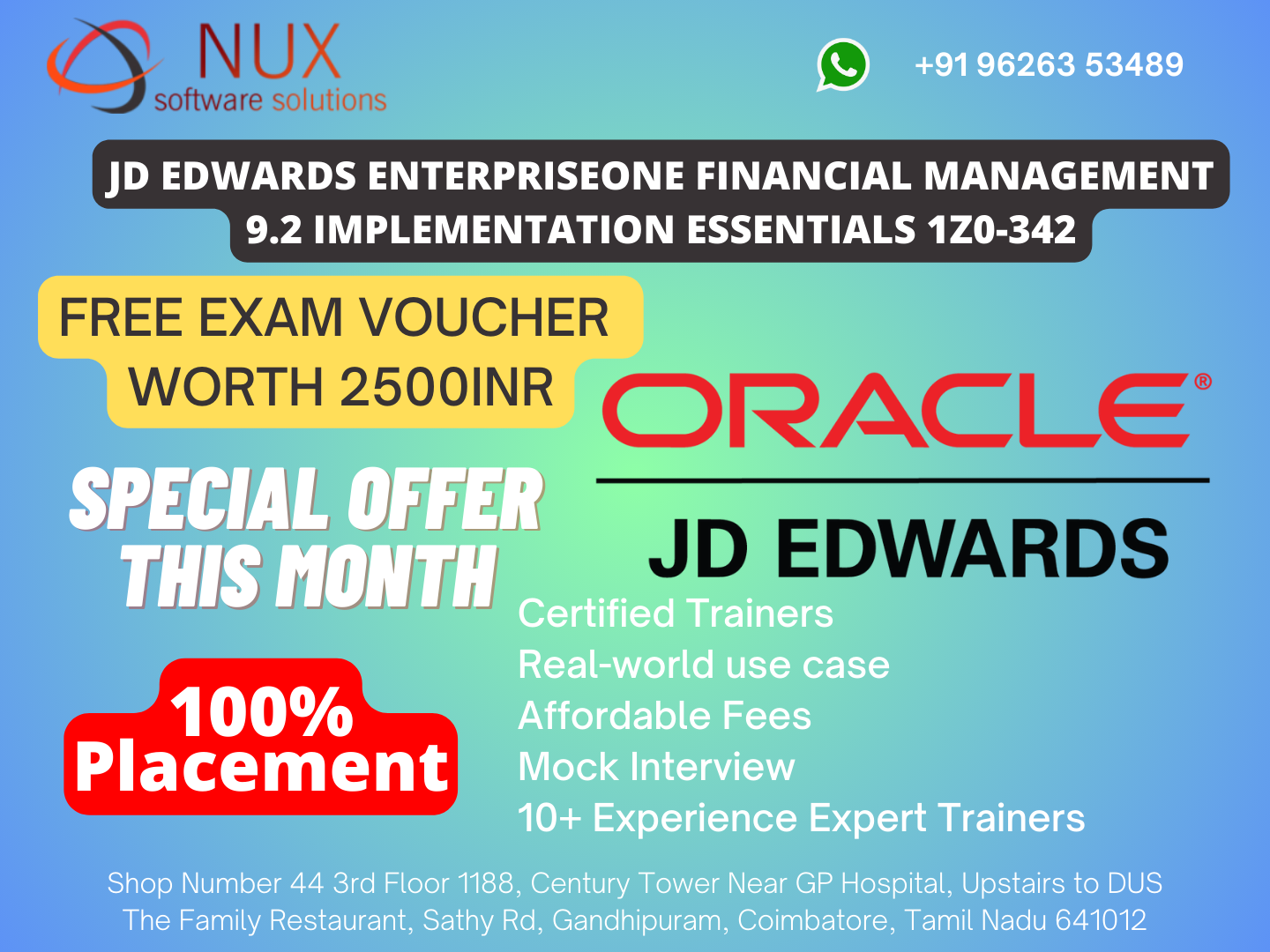Oracle E-Business Suite R12 Financial Management Certified Implementation


Best Oracle E-Business Suite R12 Financial Management Certified Implementation Certification training courses classes deliver by Nux software solutions in coimbatore. Nux software solutions in coimbatore has excellent and advanced training programs that will give you better performance & hands on experience. Our industry’s expert trainers offer a wide range of skills and experience in their graded areas.
The Training center environment is too good for professional, individual, corporate, live project training and industrial training. Labs infrastructure is advanced, well managed and you can access LAB 24X7 from anywhere. Training center has international expert trainers and they have excellent knowledge, real time industry experience.
Our Training programs combine with several innovative learning methods and delivery models. We understand your requirement and it will give you 100 percent growth for your career and provide the cost effective training programs and also work with flexibility for the trainees.
Course Syllabus
Module
Chapter 1 :
Navigating in R12 Oracle Applications
- Log in to Oracle Applications
- Navigate from Personal Home Page to Applications
- Choose a responsibility
- Create Favorites and set Preferences
- Use Forms and Menus
- Enter data using Forms
- Search for data using Forms
- Access online Help
- Run and monitor Reports and Programs
- Log out of Oracle Applications
Chapter 2 :
Shared Entities and Integration
- Explain shared entities within R12 E-Business Suite
- Describe key integration points and business flows between products in E-Business Suite (EBS)
- Identify Key Business Flows and products involved in E-Business Suite (EBS)
Chapter 3 :
Fundamentals of Multi-Org
- Define Multiple Organization (Multi-Org)
- Describe the types of organizations supported in the Multi-Org model
- Explain the entities of Multi-Org
- Explain how Multi-Org secures data
- Identify key implementation considerations for Multi-Org
- Define Multi-Org Access Control
- Explain Multi-Org preferences
- Explain Enhanced Multiple-Organization Reporting
- Explain the concepts of subledger accounting
Chapter 4 :
Oracle General Ledger Process
- Identify the steps required to complete the accounting cycle using Oracle General Ledger
- Describe how Oracle General Ledger integrates with other Oracle eBusiness applications
- Describe the integration of Oracle General Ledger with Oracle Subledgers & non-Oracle systems
- Explain implementation considerations for setting up and using Oracle General Ledger and Oracle eBusiness Suite
- Describe an overview of Accounting Setup Manager, currency concepts, budgeting, EPB, reporting & analysis
Chapter 5 :
Advanced Security
- Manage Data Access Security for Legal Entities and Ledgers
- Explain key Advanced Security setups and process
- Manage Data Access Sets
- Control security of Management Reporting
Chapter 6 :
Financial Reporting
- Explain the positioning of Financial Reporting within the Oracle General Ledger business flow
- Build basic reports
- Use key elements of the Financial Statement Generator (FSG) for creating financial reports
- Use Standard listing reports available for FSG report definitions
- Create FSG Reports with XML Publisher
- Use Web ADI for Financial Reporting
- Explain key implementation issues regarding Oracle General Ledger financial reporting
Chapter 7 :
Accounting Setups
- Create Accounting Setups
- Describe the various Subledger Accounting Options
- Perform the Primary Ledger Setup steps
- Describe Ledger Balancing Segment Value Assignments
- Perform the Secondary Ledger Setup steps
- Complete Accounting Setup
Chapter 8 :
Consolidations
- Explain overview of Consolidations and their positioning within the Oracle General Ledger business flow
- Identify the key implementation issues regarding consolidations
- Use the features and functionality of Global Consolidation System (GCS)
- Use the elements of the Consolidation Workbench
- Create eliminating entries
- Use Standard reports and inquiry options available for consolidations Ledger
- Describe the elements required to create a ledger within Oracle General Ledger
- Describe the basic components of Accounting Setup
- Describe the important elements for creating a Chart of Accounts structure
- Creating a new Accounting Flexfield structure
- Utilize the Account Hierarchy Manager to view and maintain Accounting Flexfield values
Chapter 9 :
Financial Budgeting
- Explain the anatomy of a budget
- Explain the components of budget accounting cycle
- Define budget and budget organization
- Explain Budget Entry methods
- Apply Budget Rules
- Transfer budget amounts
- Perform budget review and correction
- Translate budget balances
- Review balances in Master/Detail budgets
- Create budgets with Budget Wizards
- Use available Standard budget reports
- Plan Budget implementation requirements
Chapter 10 : Introduction to Oracle Applications R12 - Explain the footprint of R12 E-Business Suite - Describe the benefits of R12 E-Business Suite - Describe R12 E-Business Suite architecture
Chapter 11 :
Fundamentals of Flexfields
- Describe Flexfields and their components
- Identify the steps to implement a Flexfield
- Define value sets and values
- Define Key Flexfields
- Define Descriptive Flexfields
Chapter 12 :
Fundamentals of Workflow and Alerts
- Explain Workflow concepts
- Describe the benefits of Workflow
Chapter 13 :
Basic Journal Entries
- Describe how journal entries are positioned in the accounting cycle
- Describe the different Journal Posting options
- Define how to perform Account Inquiries & Drilldown to Oracle Subledger Applications
- Import journal entry information using the GL_INTERFACE table
- Plan the key elements of Web Applications Desktop Integrator (Web ADI)
- Define Web ADI setup options for key flexfields
- Utilize Web ADI profile options, forms functions, menus, and responsibilities
Chapter 14 :
Multi-Currency
- Explain Multi-Currency concepts
- Use Currency Rate Manager
- Perform Foreign currency journals Entry
- Perform Revaluation of foreign currency balances
- Translate functional balances into foreign currency
- Describe overview of Secondary Tracking Segment
- Use Foreign Currency Reports
Chapter 15 :
Accounting Setup Manager
- Describe the components of Ledger Processing options
- Describe Secondary Ledgers & Reporting Currencies
- Describe Accounting Setup considerations with one legal entity
- Describe Accounting Setup considerations with multiple legal entities
- Describe Accounting Setup considerations with no legal entities
Chapter 16 :
Advanced Journal Entries
- Create Recurring Journals
- Formulate Mass Allocation Journals
- Describe AutoAllocations and related implementation considerations
- Explain AutoScheduling
- Describe the Journal Scheduling process
- Describe key issues and considerations when implementing Advanced Journal Entry
- Describe the business benefits of using Oracle General Ledger's Advanced Journal Entry functions


